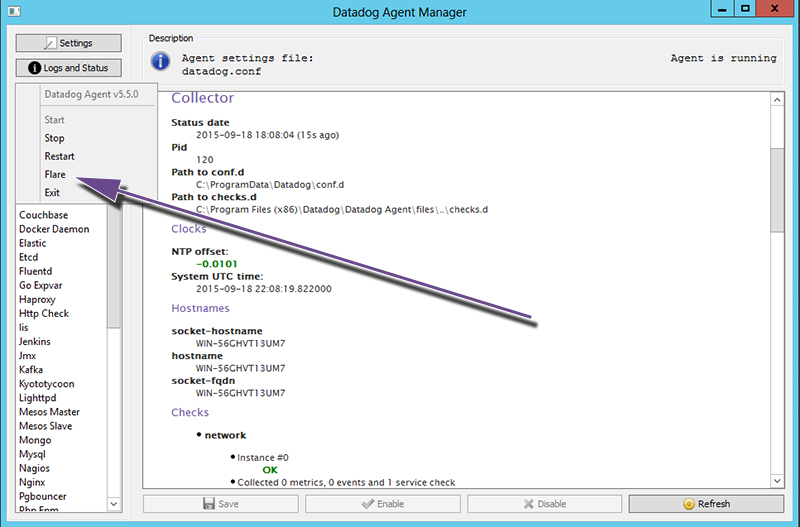- Principales informations
- Getting Started
- Datadog
- Site Datadog
- DevSecOps
- Serverless for AWS Lambda
- Agent
- Intégrations
- Conteneurs
- Dashboards
- Monitors
- Logs
- Tracing
- Profileur
- Tags
- API
- Service Catalog
- Session Replay
- Continuous Testing
- Surveillance Synthetic
- Incident Management
- Database Monitoring
- Cloud Security Management
- Cloud SIEM
- Application Security Management
- Workflow Automation
- CI Visibility
- Test Visibility
- Intelligent Test Runner
- Code Analysis
- Learning Center
- Support
- Glossary
- Standard Attributes
- Guides
- Agent
- Intégrations
- OpenTelemetry
- Développeurs
- Authorization
- DogStatsD
- Checks custom
- Intégrations
- Create an Agent-based Integration
- Create an API Integration
- Create a Log Pipeline
- Integration Assets Reference
- Build a Marketplace Offering
- Create a Tile
- Create an Integration Dashboard
- Create a Recommended Monitor
- Create a Cloud SIEM Detection Rule
- OAuth for Integrations
- Install Agent Integration Developer Tool
- Checks de service
- IDE Plugins
- Communauté
- Guides
- API
- Application mobile
- CoScreen
- Cloudcraft
- In The App
- Dashboards
- Notebooks
- DDSQL Editor
- Alertes
- Infrastructure
- Métriques
- Watchdog
- Bits AI
- Service Catalog
- API Catalog
- Error Tracking
- Service Management
- Infrastructure
- Universal Service Monitoring
- Conteneurs
- Sans serveur
- Surveillance réseau
- Cloud Cost
- Application Performance
- APM
- Profileur en continu
- Database Monitoring
- Agent Integration Overhead
- Setup Architectures
- Configuration de Postgres
- Configuration de MySQL
- Configuration de SQL Server
- Setting Up Oracle
- Setting Up MongoDB
- Connecting DBM and Traces
- Données collectées
- Exploring Database Hosts
- Explorer les métriques de requête
- Explorer des échantillons de requêtes
- Dépannage
- Guides
- Data Streams Monitoring
- Data Jobs Monitoring
- Digital Experience
- RUM et Session Replay
- Product Analytics
- Surveillance Synthetic
- Continuous Testing
- Software Delivery
- CI Visibility
- CD Visibility
- Test Visibility
- Exécuteur de tests intelligent
- Code Analysis
- Quality Gates
- DORA Metrics
- Securité
- Security Overview
- Cloud SIEM
- Cloud Security Management
- Application Security Management
- AI Observability
- Log Management
- Pipelines d'observabilité
- Log Management
- Administration
Send an Agent 5 flare
Cette page n'est pas encore disponible en français, sa traduction est en cours.
Si vous avez des questions ou des retours sur notre projet de traduction actuel, n'hésitez pas à nous contacter.
Si vous avez des questions ou des retours sur notre projet de traduction actuel, n'hésitez pas à nous contacter.
This page covers the ports used by Agent 5. For information on the latest version of the Agent, see Send a Flare.
| Platform | Command |
|---|---|
| Docker | docker exec -it dd-agent /etc/init.d/datadog-agent flare <CASE_ID> |
| macOS | datadog-agent flare <CASE_ID> |
| CentOS | sudo service datadog-agent flare <CASE_ID> |
| Debian | sudo service datadog-agent flare <CASE_ID> |
| Kubernetes | kubectl exec <POD_NAME> -it /etc/init.d/datadog-agent flare <CASE_ID> |
| Fedora | sudo service datadog-agent flare <CASE_ID> |
| Redhat | sudo service datadog-agent flare <CASE_ID> |
| SUSE | sudo service datadog-agent flare <CASE_ID> |
| Source | sudo ~/.datadog-agent/bin/agent flare <CASE_ID> |
| Windows | See the Windows section |
Note: If you are using a Linux based system and the service wrapper command is not available, consult the list of alternatives.
Windows
To send Datadog support a copy of your Windows logs and configurations, do the following:
Open the Datadog Agent Manager.
Select Actions.
Select Flare.
Enter your ticket number (if you don’t have one, leave the value as zero).
Enter the email address you use to log in to Datadog.
The flare command is available for PowerShell:
& "$env:ProgramFiles\Datadog\Datadog Agent\embedded\python.exe" "$env:ProgramFiles\Datadog\Datadog Agent\agent\agent.py" flare <CASE_ID>
or cmd.exe:
"%ProgramFiles%\Datadog\Datadog Agent\embedded\python.exe" "%ProgramFiles%\Datadog\Datadog Agent\agent\agent.py" flare <CASE_ID>
Flare fails to upload
The output of the flare command tells you where the compressed flare archive is saved. In case the file fails to upload to Datadog, you can retrieve it from this directory and manually add as an attachment to an email. Common locations flare files are stored:
- Linux:
\tmp\ - MacOS:
$TMPDIR - Windows:
C:\Users\<DDAGENTUSER>\AppData\Local\Temp\
For older Agent versions on Windows, you can find the location of this file by running the following from the Agent’s Python command prompt:
Step 1:
Agent v5.12+:
"%ProgramFiles%\Datadog\Datadog Agent\dist\shell.exe" sinceOlder Agent versions:
"%ProgramFiles%\Datadog\Datadog Agent\files\shell.exe"
Step 2:
import tempfile
print tempfile.gettempdir()
Example:
For information on the latest version of the Agent, consult the Windows documentation.


